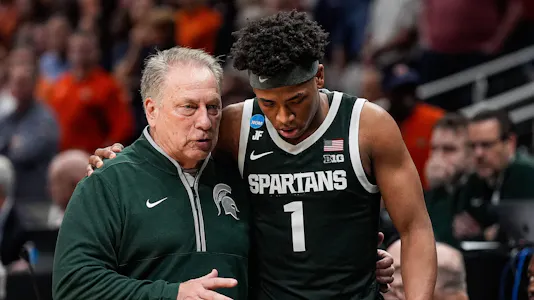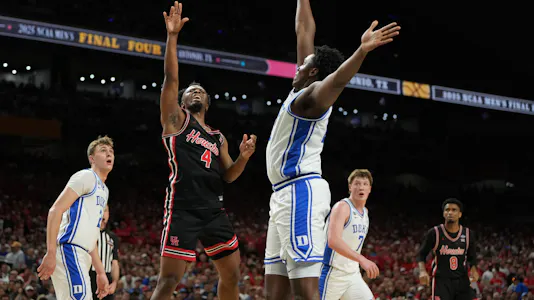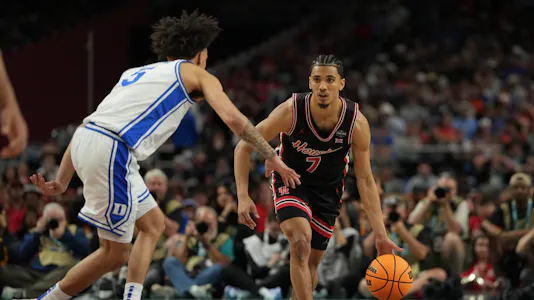What is a March Madness Calcutta Auction? Tips, Strategy & How to Run Your Own Contest

Last Updated: March 16, 2025 8:30 PM EDT • 10 minute read X Social Google News Link

There are so many ways to enjoy March Madness, with the most obvious one being via a March Madness bracket, but don't let that be the only avenue for immersing yourself in the NCAA Tournament.
While brackets and survivor contests are the simplest way to get involved, there's a third option for those wanting a little more ... so what is a March Madness Calcutta auction?
For more on this year's bracket, check out our March Madness bracket reactions.

🏀 What is a March Madness Calcutta auction? A beginner's guide
🔨 What is a Calcutta auction?
A Calcutta auction is a betting format often used for golf tournaments and the NCAA Tournament where participants bid on teams or players in a live auction format. The highest bidder for each team/player is awarded that team with all the money spent at the auction going toward the pot and payout for the winners of the Calcutta auction.
🧠 How does an NCAA Tournament auction work?
When it comes to Calcutta auctions, the NCAA Tournament is the perfect event for them because of the sheer amount of teams involved.
With 68 teams (or 64 if you auction the First Four teams together) you'll likely want somewhere between four and 12 participants in the contest. The ideal number is eight participants with each having eight teams (using 64 instead of 68), but the total number of teams each participant has doesn't necessarily have to be even.
Once you have the number set, you can organize a live auction either in person, via video call, or online with each team being auctioned off to the highest bidder. The total amount spent at the auction then becomes the prize pool.
There's no universal scoring system for a March Madness Calcutta auction with a few common ways to score it and build the payout structure.
💸 What's the payout format of a March Madness Calcutta Auction?
The payout format for a March Madness Calcutta auction can vary with the two most popular options being payouts based on round advancement or using a weighted point system. There's also the freedom to implement other scoring options and change the payout structure to what works best for your pool - you can also set a cap to limit how much money is spent overall on the auction.
📝 Round advancement payout
Participants earn a percentage of the total pot based on how far their teams advance. Example:
- Champion: 30-40% of the pot
- Runner-up: 10-15%
- Final Four (each team): 5-10%
- Elite Eight (each team): 3-5%
- Sweet 16 (each team): 1-2%
📝 Point system
With each round a team advances to, the participant earns points, and the payout is based on total points. The prize pool can be distributed however the participants want with the participant with the most points earning the largest percentage of the pot. Example:
- First round win: 1 point
- Second round win: 2 points
- Sweet 16 win: 4 points
- Elite Eight win: 8 points
- Final Four win: 16 points
- Championship win: 32 points
📝 Other scoring options
- Upset bonuses: Reward additional points or pot money to participants whose teams pull off major upsets
- Lowest bid bonus: Reward additional points or pot money if the cheapest team wins a game
- Perfect Final Four: Reward additional pot money if one participant has all four Final Four teams
💡 What's the best March Madness Calcutta auction strategy?

🔍 Identify the best value
The top seeds will go for the most money, but the underdogs that are cheaper can lead to big payouts if you can identify the Cinderella teams. Every year we see lower seeds make runs to the Sweet 16 and even make it as far as the Final Four, so landing one of those programs can make a huge difference in a Calcutta auction.
To help you gauge the value of each team prior to the Calcutta auction, you can calculate the expected value of each program. Do this by multiplying the probability of a team advancing to each round by the payout percentage of each round.
Using the Final Four odds for example, we can figure out the probability of each team advancing to the final weekend of the NCAA Tournament. Then we can multiply that by the payout of having a team make the Final Four in a Calcutta auction (we'll use 15% for the purpose of this formula).
- Team A has a 12.5% chance of making the Final Four (+700)
- If they make the Final Four, the participant who has Team A receives 15% of the total pot
- The total pot is $1,000
- The calculation is 0.125 x 0.15 x 1,000 = 18.75
- That means the expected value of the team is $18.75
While backing favorites is smart, don't overpay for them if they're not worth the cost. If someone is paying $40 for Team A in our example, is it really worth paying double the expected value?
Instead, identify the best value teams. Usually with participants so heavily focused on No. 1 or No. 2 seeds, you can get teams seeded No. 3 to No. 6 at somewhat of a discount. You can also use KenPom to find teams who may be under seeded relative to where they're ranked by the advanced metrics.
And don't be afraid to bid on mid-majors that dominated their season and conference tournaments like UC San Diego or McNeese State.
🔢 Budget and bid on all seeds
While Calcutta auctions normally don't have salary caps, you should set a budget for yourself in an effort to not overspend. And you shouldn't blow your budget all on one team and then end up having to stack lower seeds around it to fill out your roster of teams.
For example, if you set your budget at $300 and you want to have eight teams, don't blow 50% of it on one. You want to be able to have a well-rounded portfolio with a mix of true title contenders (teams seeded No. 1 to No. 4 have accounted for 36 of 39 NCAA Tournament titles since 1985), middle seeds that can make a push to the Elite Eight (No. 5 to No. 9), and underdogs that can push to a Sweet 16 (No. 11 seeds have historically been the strongest).
Diversifying your picks becomes even more important in there are upset bonuses, because as we all know, March Madness is full of unpredictable outcomes.
⏳ Bid early but don't get into a bidding war
Bidding early on sleepers can be a smart move because they may have less participants interested in them as they plan to save their money to drop it on the top-seeded programs. So identify teams you like that are lower seeds and go after them, but don't get into a bidding war.
Instead, you can help drive the price up on top teams by bidding while setting a limit for how much you'll bid. If there's a participant who is all-in on Duke, drive the price up and force them to overspend. Every dollar they spend is extra money in your pocket for every winning team in your portfolio, since the prize pool is determined by overall spending.
This season in particular has been full of parity with Duke and Auburn clearly looking like the best programs for much of the season. That could allow you to find value in teams like Houston, Florida, Tennessee, Alabama, Michigan State, and St. John's - all of whom have championship potential but less buzz around them than the Blue Devils and Tigers.
🤔 Think about the payout structure
Don't get caught up in throwing money at top teams and remember to focus on the payout structure. Build your bidding plan around how much each round pays and calculate the expected value of every team.
If there's an upset bonus, try to target potential upsets where a lower seed is being undervalued or a higher seed is being overvalued. If the pool pays for big upsets, be aggressive about adding the double-digit seeds you've identified as potential Cinderellas - and if not, build a strong repertoire focused on finding teams that stack well together.
📋 How do you run a March Madness Calcutta Auction?
⚙️ Set the rules
📝 Auction format
- If it's an in person auction, track it on a board for everyone to see how much each team is going for
- If it's online auction, make sure to make the results easily accessible throughout the auction
- Decide the order in which teams will be auctioned (region-by-region, highest to lowest, lowest to highest, etc.)
📝 Bidding rules
- Open bidding: Participants all bid together with everyone's bid known and the team going to the highest bidder
- Silent auction: Participants submit their bids secretly without any other participants knowing the bids of others and the highest bid wins
- Bid increments: Set minimum increments for bids to keep the bidding speed appropriate
📝 Payment
- Collect all funds after the auction and make the total pot known
- Provide each participant with the payout numbers based on the format and the total pot collected
⚖️ Decide on the payout format
Decide on the specifics of the payout format and if you want there to be upset bonuses or lowest bid payouts (rewarding the cheapest team if they pull off a win).
This is a common Calcutta auction payout structure:
- Champion: 30-40% of the pot
- Runner-up: 10-15%
- Final Four (each team): 5-10%
- Elite Eight (each team): 3-5%
- Sweet 16 (each team): 1-2%
🏠 Prep and host the auction
📝 Create a team sheet
- List all teams in the tournament (64 or 68)
- List them in order of the auction (if you're going highest to lowest, list the No. 1 seeds first)
- Include seeds and win probabilities beside each team
- You can also provide a minimum bid beside each based on their seed
📝 Set the auction rules
- Set a time limit for bidding on each team
- Shoot for a minimum of two hours for the auction to ensure participants aren't overly rushed, but don't spend more than two minutes on each team
- Decide whether it's open bidding or silent bidding
📝 Host the auction
- It's recommended that you start with lower seeds to get the auction started and work your way up to higher seeds (this also forces bidders to be more strategic)
- Track everything throughout the auction so participants can refer to what prices have been paid for which team
- Track the overall pot throughout as teams are auctioned off so that participants can see how much they should be spending relative to how much they could win
- After the auction send a list to every participant showing how much each team went for and who owns which with how much they paid overall
💼 Manage the Calcutta pool
During the tournament, stay on top of the pool by providing updates on which teams are eliminated and how much those teams cost during the auction. After each round, provide every team with an update of which teams they have left so participants can see who's in the best shape. Once the tournament comes to an end, provide a list showing how much of the pot each participant earned and which teams earned them their prize.
✨ Other ways to get involved with March Madness
- March Madness bracket: How to fill out March Madness bracket
- Survivor pool: What is a March Madness survivor pool?
📅 March Madness key dates
- Selection Sunday: March 16
- First Four: March 18-19
- First round: March 20-21
- Second round: March 22-23
- Sweet 16: March 27-28
- Elite Eight: March 29-30
- Final Four: Saturday, April 5
- National championship game: Monday, April 7
🔮 March Madness predictions for every game today
- Louisville vs. Creighton prediction
- Purdue vs. High Point prediction
- Wisconsin vs. Montana prediction
- Houston vs. SIU Edwardsville prediction
- Auburn vs. Alabama State prediction
- Clemson vs. McNeese prediction
- BYU vs. VCU prediction
- Gonzaga vs. Georgia prediction
- Tennessee vs. Wofford prediction
- Kansas vs. Arkansas prediction
- Texas A&M vs. Yale prediction
- Missouri vs. Drake prediction
- UCLA vs. Utah State prediction
- St. John's vs. Omaha prediction
- Michigan vs. UC San Diego prediction
- Texas Tech vs. UNC Wilmington prediction
💰 March Madness betting odds pages
| March Madness odds | March Madness MVP odds |
| Women's March Madness odds | March Madness MVP predictions |
| Final Four odds | March Madness prop bets |
👑 Best March Madness betting sites
Ready to place your March Madness bets? Check out the best March Madness betting promos from our best March Madness betting sites, as determined by our expert team at Sportsbook Review.
- Caesars Promo Code: SBRBONUSDYW | Read our Caesars Review
- BetMGM Bonus Code: SBRBONUS | Read our BetMGM Review
- bet365 Bonus Code: SBRBONUS | Read our bet365 Review
- FanDuel Promo Code | Read our FanDuel Review
- DraftKings Promo Code | Read our DraftKings Review
(21+. Gambling Problem? Call 1-800-GAMBLER)
* Bonuses not applicable in Ontario.
Not intended for use in MA.
Each betting site featured on SBR has been meticulously researched and selected by our team of experts. If you sign up through our links, we may get a commission

Rob Paul X social





